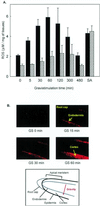Role of auxin-induced reactive oxygen species in root gravitropism
- PMID: 11457956
- PMCID: PMC116462
- DOI: 10.1104/pp.126.3.1055
Role of auxin-induced reactive oxygen species in root gravitropism
Abstract
We report our studies on root gravitropism indicating that reactive oxygen species (ROS) may function as a downstream component in auxin-mediated signal transduction. A transient increase in the intracellular concentration of ROS in the convex endodermis resulted from either gravistimulation or unilateral application of auxin to vertical roots. Root bending was also brought about by unilateral application of ROS to vertical roots pretreated with the auxin transport inhibitor N-1-naphthylphthalamic acid. Furthermore, the scavenging of ROS by antioxidants (N-acetylcysteine, ascorbic acid, and Trolox) inhibited root gravitropism. These results indicate that the generation of ROS plays a role in root gravitropism.
Figures




Similar articles
-
The role of calcium in the regulation of hormone transport in gravistimulated roots.Adv Space Res. 1992;12(1):211-8. doi: 10.1016/0273-1177(92)90285-6. Adv Space Res. 1992. PMID: 11536959
-
The microtubule cytoskeleton does not integrate auxin transport and gravitropism in maize roots.Physiol Plant. 1999 Apr;105(4):729-38. doi: 10.1034/j.1399-3054.1999.105418.x. Physiol Plant. 1999. PMID: 11542390
-
Effects of ethylene on the kinetics of curvature and auxin redistribution in gravistimulated roots of Zea mays.Plant Physiol. 1990;94(4):1770-5. doi: 10.1104/pp.94.4.1770. Plant Physiol. 1990. PMID: 11537475 Free PMC article.
-
Auxin transport during root gravitropism: transporters and techniques.Plant Biol (Stuttg). 2014 Jan;16 Suppl 1:50-7. doi: 10.1111/plb.12030. Epub 2013 May 3. Plant Biol (Stuttg). 2014. PMID: 23648074 Review.
-
Computer based imaging and analysis of root gravitropism.Gravit Space Biol Bull. 1997 Jun;10(2):65-73. Gravit Space Biol Bull. 1997. PMID: 11540122 Review.
Cited by
-
Flavonols modulate lateral root emergence by scavenging reactive oxygen species in Arabidopsis thaliana.J Biol Chem. 2021 Jan-Jun;296:100222. doi: 10.1074/jbc.RA120.014543. Epub 2020 Dec 25. J Biol Chem. 2021. PMID: 33839683 Free PMC article.
-
Comprehensive transcript profiling of two grapevine rootstock genotypes contrasting in drought susceptibility links the phenylpropanoid pathway to enhanced tolerance.J Exp Bot. 2015 Sep;66(19):5739-52. doi: 10.1093/jxb/erv274. Epub 2015 Jun 2. J Exp Bot. 2015. PMID: 26038306 Free PMC article.
-
oiwa, a female gametophytic mutant impaired in a mitochondrial manganese-superoxide dismutase, reveals crucial roles for reactive oxygen species during embryo sac development and fertilization in Arabidopsis.Plant Cell. 2013 May;25(5):1573-91. doi: 10.1105/tpc.113.109306. Epub 2013 May 7. Plant Cell. 2013. PMID: 23653473 Free PMC article.
-
Identification of the PmWEEP locus controlling weeping traits in Prunus mume through an integrated genome-wide association study and quantitative trait locus mapping.Hortic Res. 2021 Jun 1;8(1):131. doi: 10.1038/s41438-021-00573-4. Hortic Res. 2021. PMID: 34059642 Free PMC article.
-
Ascorbic acid deficiency activates cell death and disease resistance responses in Arabidopsis.Plant Physiol. 2005 Nov;139(3):1291-303. doi: 10.1104/pp.105.067686. Epub 2005 Oct 21. Plant Physiol. 2005. PMID: 16244149 Free PMC article.
References
-
- Alvarez ME, Pennel RI, Meijer P-J, Ishikawa A, Dixon RA, Lamb C. Reactive oxygen intermediates mediate a systemic signal network in the establishment of plant immunity. Cell. 1998;92:773–784. - PubMed
-
- Bae YS, Kang SW, Seo MS, Baines IC, Tekle E, Chock PB, Rhee SG. Epidermal growth factor (EGF)-induced generation of hydrogen peroxide: role in EGF receptor-mediated tyrosine phosphorylation. J Biol Chem. 1997;272:217–221. - PubMed
-
- Chen Z, Silva H, Klessig DF. Active oxygen species in the induction of plant systemic acquired resistance by salicylic acid. Science. 1993;262:1883–1886. - PubMed
-
- Cholodny N. Beitrage zur Analyze der Geotropischen Reaktion. Jahrb Wiss Bot. 1926;65:447–459.
-
- Delledonne M, Xia Y, Dixon RA, Lamb C. Nitric oxide functions as a signal in plant disease resistance. Nature. 1998;394:585–588. - PubMed
Publication types
MeSH terms
Substances
LinkOut - more resources
Full Text Sources

